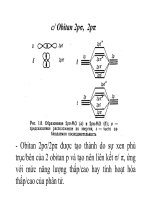Bài giảng hoá học hữu cơ caboxylic
Bạn đang xem bản rút gọn của tài liệu. Xem và tải ngay bản đầy đủ của tài liệu tại đây (928.46 KB, 69 trang )
Carboxylic Acids
Introduction
• The functional group of carboxylic acids
COOH consists of a C=O with -OH
bonded to the same carbon..
• Aliphatic acids have an alkyl group
bonded to -COOH.
• Aromatic acids have an aryl group bonded
to -COOH.
• Fatty acids are long-chain aliphatic acids.
=>
Some Important Acids
• CH3COOH is in vinegar and other foods,
used industrially as solvent, catalyst,
and reagent for synthesis.
• Fatty acids from fats and oils.
• C6H5COOH-Benzoic acid in drugs,
preservatives.
• Adipic acid used to make nylon 66.
• Phthalic acid used to make polyesters.
=>
Nobel Prize 1982
lessens pain, anti inflammation
BiochemistSune K.Bergstrom, Bengt I.Samuelsson và John R.Vane
Plant Hormone
Gibberellin (GA)
IBA-Indol butyric
Phenyl acetic
IAA-Indol Acetic
Biosynthesis of Shikimic acid
Tamiflu
L-Ascorbic acid (Vitamin C)
Antioxidant
Common Names
• Aliphatic acids have historical names.
• Positions of substituents on the chain are
labeled with Greek letters.
Cl O
CH3CH2CHC OH
α-chlorobutyric acid
Ph
CH3CH2CH2CHCH2COOH
β-phenylcaproic acid
=>
IUPAC Names
• Remove -e from alkane (or alkene)
name, add -oic acid.
• The carbon of the carboxyl group is #1.
Cl O
CH3CH2CHC OH
2-chlorobutanoic acid
Ph
H
H
C
C
COOH
trans-3-phenyl-2-propenoic
acid (cinnamic acid)
=>
Naming Cyclic Acids
• Cycloalkanes bonded to -COOH are named
as cycloalkanecarboxylic acids.
• Aromatic acids are named as benzoic acids.
COOH
CH(CH3)2
COOH
OH
2-isopropylcyclopentanecarboxylic acid o-hydroxybenzoic acid
(salicylic acid)
=>
Dicarboxylic Acids
• Aliphatic diacids are usually called by
their common names.
• IUPAC name, number the chain from the
end closest to a substituent.
• Two carboxyl groups on a benzene ring
indicate a phthalic acid.
Br
HOOCCH2CHCH2CH2COOH
3-bromohexanedioic acid
β-bromoadipic acid
=>
Butenedioic acid
H
H
C
HOOC
H
COOH
C
C
COOH
maleic acid
HOOC
C
H
fumaric acid
Butenedioic acid
H
H
C
O
C
C
H
C
C
O
H
H O
O
O
C
C
C
O H
O
O
But on releasing the second proton, such extra
stability may be lost and therefore Ka2 is smaller
for cis-isomer.
Butenedioic acid
H
H
C
O
C
C
C
OH
H O
o H
heated to 100 C
O
O
H
C
C
C
C
O
O
Structure of Carboxyl
• Carbon is sp2 hybridized.
• Bond angles are close to 120°.
• O-H eclipsed with C=O, to get overlap of π
orbital with orbital of lone pair on oxygen.
=>
Boiling Points
Higher boiling points than similar
alcohols, due to dimer formation.
Acetic acid, b.p. 118°C
Ethanol, b.p. 78°C
=>
Melting Points
• Aliphatic acids with more than 8
carbons are solids at room temperature.
• Double bonds (especially cis) lower the
melting point. Note these 18-C acids:
Stearic acid (saturated): 72°C
Oleic acid (one cis double bond): 16°C
Linoleic acid (two cis double bonds): -5°C
=>
Solubility
• Water solubility decreases with the length
of the carbon chain.
• Up to 4 carbons, acid is miscible in water.
• More soluble in alcohol.
• Also soluble in relatively nonpolar
solvents like chloroform because it
dissolves as a dimer.
=>
Acidity
Resonance Stabilization
=>
Substituent Effects on Acidity
COOH
COOH
COOH
COOH
COOH
NO 2
NO2
OCH3
p-methoxy benzoic acid
pKa = 4.46
m-nitro
pKa = 4.19 pKa = 3.47
NO2
p-nitro
o-nitro
pKa = 3.41
pKa = 2.16
=>
Salts of Carboxylic Acids
• Sodium hydroxide removes a proton to
form the salt.
• Adding a strong acid, like HCl,
regenerates the carboxylic acid.
O
CH3
C OH
NaOH
O
CH3
_ +
C O Na
HCl
=>
Naming Acid Salts
• Name the cation.
• Then name the anion by replacing the
-ic acid with -ate.
Cl
-
CH3CH2CHCH2COO K
+
potassium β-chlorovalerate
potassium 3-chloropentanoate
=>
Properties of Acid Salts
• Usually solids with no odor.
• Carboxylate salts of Na+, K+, Li+, and NH4+
are soluble in water.
• Soap is the soluble sodium salt of a
long chain fatty acid.
• Salts can be formed by the reaction of
an acid with NaHCO3, releasing CO2.
=>
Purifying an Acid









